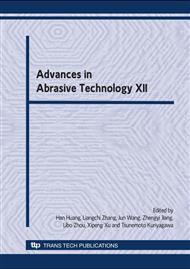p.125
p.131
p.137
p.143
p.149
p.155
p.163
p.169
p.175
Quantification Method of Cutting-Edge Density Considering Grain Distribution and Grinding Mechanism
Abstract:
In this study, the quantification method of the cutting-edge density is proposed because of its close relation to the grinding mechanism. The cutting-edge density depends upon not only the grain distribution but also the thickness of effective cutting-edge layer. Therefore, the quantification of the cutting-edge density requires measuring not only the profile but also the grinding force. The thickness of effective cutting-edge layer can be determined based on the grain distribution, the grinding force and the stiffness of a grinding wheel. From applied result of the proposed method for the actual grinding process, the cutting-edge density and the effective cutting-edges layer is determined appropriately corresponding to the change in the working surface condition.
Info:
Periodical:
Pages:
149-154
Citation:
Online since:
June 2009
Price:
Сopyright:
© 2009 Trans Tech Publications Ltd. All Rights Reserved
Share:
Citation:


